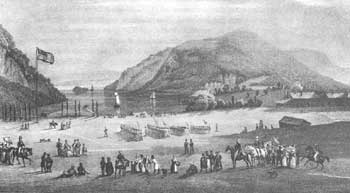





Survey of Historic Sites and Buildings
 |
UNITED STATES MILITARY ACADEMY New York |
|
| ||
Ownership and Administration. U.S. Govemment; Department of Defense.
Significance. Since 1802 this Academy has trained the nucleus of Regular Army officers who have commanded U.S. troops throughout the world, in peace and war. Its story is woven into the panorama of national growth, from the struggle for independence to the emergence of the Nation as a world power. Its graduates include most of our distinguished military leaders of the 19th and 20th centuries. Because troops have been stationed at the Academy site continuously since January 1778, it is the oldest permanently occupied military post in the country.
Recognizing the strategic importance of West Point as the key to navigation of the Hudson River, a U.S. lifeline during the War for Independence, in January 1778 Gen. George Washington stationed a garrison there. In March, under Washington's direction, Thaddeus Kosciuszko, the Polish engineer, began constructing fortifications at the site. This work continued through the war. For 4 months in 1779 Washington made his headquarters at the Point. The following year Benedict Arnold, the commander, attempted to betray the post to the British, but fled to the enemy when the plot came to light. In 1781 a corps of veterans was assigned to instruct candidates for Army commissions, but the end of hostilities in 1783 and national fear of a standing army led to the near abandonment of the post. During the war the British never directly attacked it.
As early as 1776 Gen. Henry Knox had proposed the founding of a school for the instruction of Army officers. Washington and Alexander Hamilton supported this proposal. When Congress, in 1783, asked Washington for his views on the organization and maintenance of the Nation's peacetime forces, the former commander in chief sought the advice of the officers who had served under him. Among these was the able drillmaster Baron von Steuben, who recommended an academy where cadets would receive a liberal education, supplemented by specialized instruction in engineering and the use of artillery. Taking note of the views of von Steuben and others, Washington recommended a small standing army and one or more military academies. The weak central Government under the Articles of Confederation could do little to carry out these recommendations and rejected the academy proposal as not worth the expense.
In 1790, to save the annual rental charge of $437, the Federal Government purchased the land at West Point from its private owner. In the early part of the administration of Washington, he and his Cabinet again considered the founding of a military academy, but Thomas Jefferson doubted its constitutionality and Congress let the matter die. As the foreign threat became more serious, though, demands increased for adequate seacoast defenses and trained artillerymen and engineers. In 1794 the Government organized an academy at West Point that offered rudimentary training in artillery practice and engineering, but it operated for only a few weeks until fire destroyed the building.
Jefferson, meanwhile, had reversed his views on an academy. When he became President, in 1801, he directed his Secretary of War to reestablish it. The following year Congress formally recognized it, construction began, and the Military Academy opened the following July 4. In the first few years proper equipment and good instructors were scarce. In 1817 Maj. Sylvanus Thayer, who for the previous 2 years had traveled in Europe to observe military schools there and who was an 1808 graduate of West Point, became superintendent. He completely reorganized the Academy and inaugurated many practices that are still followed today.
 |
| A parade at West Point. Lithographed by L. Sabatier, figures by V. Adams, from the drawing "Plain of West Point at the Moment of Exercise," by Jacques G. Milbert. Courtesy, Library of Congress. |
Present Appearance. The Academy grounds are open to visitors throughout the year, but many of the buildings and training areas are closed to the public. An information center is located at the South (Thayer) Gate. The West Point museum is a point of major interest. At Trophy Point is the West Point Battle Monument, around which are displayed artillery and other relics of U.S. wars. Numerous interesting memorials are located around the grounds. The Cadet Chapel, erected in 1910, is a fine example of Gothic architecture.
NHL Designation: 12/19/60
 |
 |
http://www.cr.nps.gov/history/online_books/founders-frontiersmen/sitec31.htm
Last Updated: 29-Aug-2005